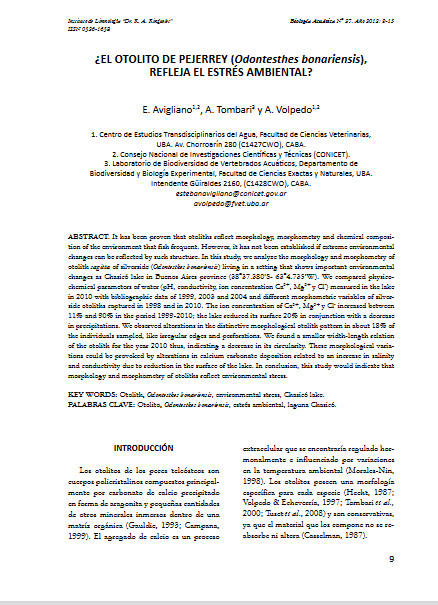¿El otolito de pejerrey (Odontesthes bonariensis), refleja el estrés ambiental?
Licencia: Creative Commons (by-nc-sa)
Autor(es): Avigliano, Esteban; [et al.]
It has been proven that otoliths reflect morphology, morphometry and chemical composition of the environment that fish frequent. However, it has not been established if extreme environmental changes can be reflected by such structure. In this study, we analyze the morphology and morphometry of otolith sagitta of silverside (Odontesthes bonariensis) living in a setting that shows important environmental changes as Chasicó lake in Buenos Aires province (38°37.380'S- 63°4.735'W). We compared physicochemical parameters of water (pH, conductivity, ion concentration Ca2+, Mg2+ y Cl-) measured in the lake in 2010 with bibliographic data of 1999, 2003 and 2004 and different morphometric variables of silverside otoliths captured in 1998 and in 2010. The ion concentration of Ca2+, Mg2+ y Cl- increased between 11% and 90% in the period 1999-2010; the lake reduced its surface 20% in conjunction with a decrease in precipitations. We observed alterations in the distinctive morphological otolith pattern in about 18% of the individuals sampled, like irregular edges and perforations. We found a smaller width-length relation of the otolith for the year 2010 thus, indicating a decrease in its circularity. These morphological variations could be provoked by alterations in calcium carbonate deposition related to an increase in salinity and conductivity due to reduction in the surface of the lake. In conclusion, this study would indicate that morphology and morphometry of otoliths reflect environmental stress.
[2012]
Compartir:
Una vez que el usuario haya visto al menos un documento, este fragmento será visible.


